
Mangifera is a genus of flowering plants in the cashew family, Anacardiaceae. It contains about 69 species, with the best-known being the common mango. The center of diversity of the genus is in the Malesian ecoregion of Southeast Asia, particularly in Sumatra, Borneo, and the Malay peninsula. They are generally canopy trees in lowland rainforests, reaching a height of 30–40 m (98–131 ft).

The Annonaceae are a family of flowering plants consisting of trees, shrubs, or rarely lianas commonly known as the custard apple family or soursop family. With 108 accepted genera and about 2400 known species, it is the largest family in the Magnoliales. Several genera produce edible fruit, most notably Annona, Anonidium, Asimina, Rollinia, and Uvaria. Its type genus is Annona. The family is concentrated in the tropics, with few species found in temperate regions. About 900 species are Neotropical, 450 are Afrotropical, and the remaining are Indomalayan.

Cananga is a small genus of trees in the family Annonaceae, native to Indo-China and Malesia, but introduced elsewhere. One of its species, Cananga odorata, is important as the source of the perfume ylang-ylang.

Baccaurea is a genus of flowering plant belonging to the family Phyllanthaceae. The genus comprises over 100 species, distributed from Malesia to the West Pacific. It is dioecious, with male and female flowers on separate plants. Many species contain edible fruits.

Degeneria is a genus of flowering plants endemic to Fiji. It is the only genus in the family Degeneriaceae. The APG IV system of 2016, recognizes this family, and assigns it to the order Magnoliales in the clade magnoliids.

Dalbergia oliveri is a species of legume in the family Fabaceae which grows in tree form to 15 – 30 meters in height. The fruit is a green pod containing one to two seeds which turn brown to black when ripe. It is threatened by habitat loss and over-harvesting for its valuable red "rosewood" timber.

Buchanania cochinchinensis, commonly known as charoli nut, almondette, Cuddapah almond, calumpong, Hamilton mombin, is a deciduous tree of the cashew family. The charoli tree is native to the Indian subcontinent, South Central China, and much of Southeast Asia.
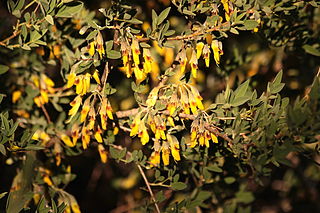
Anagyris is a genus of flowering plants in the family Fabaceae. It belongs to the subfamily Faboideae.

Cheirostylis, commonly known as fleshy jewel orchids or velvet orchids, is a genus of about sixty species of flowering plants in the orchid family Orchidaceae. Plants in this genus are terrestrial herbs with a caterpillar-like rhizome and a loose rosette of leaves. Small, white, hairy flowers develop as the leaves wither. They are found in tropical Africa, southern Asia, Southeast Asia, Malesia, New Guinea and Australia.
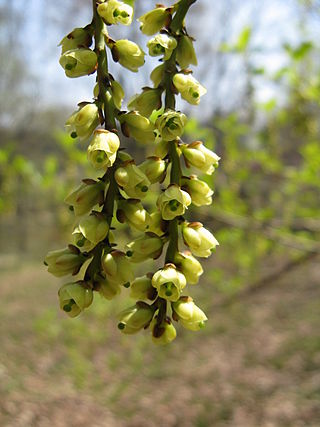
Stachyurus is the only genus in the flowering plant family Stachyuraceae, native to the Himalayas and eastern Asia. They are deciduous shrubs or small trees with pendent racemes of 4-petalled flowers which appear on the bare branches before the leaves. The plants have leaves with serrate margins.
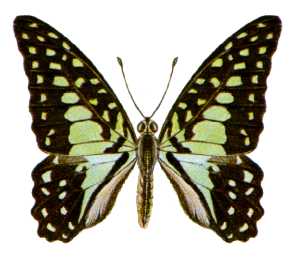
Graphium macfarlanei, the green triangle butterfly or green triangle, is a butterfly of the family Papilionidae. It is found along the northern Gulf and north-eastern coast of Queensland, Australia; as well as on the Moluccas, New Guinea, Admiralty Islands and New Britain.
Momordin is one of several saponins derived from oleanolic acid, a triterpenoid. These chemical compounds are found in some plants of the genus Momordica, which includes the bitter melon and the balsam apple, as well as in other Asian herbal medicine plants such as Kochia scoparia and Ampelopsis radix.

Periploca is a genus of plants in the family Apocynaceae, first described for modern science by Linnaeus in 1753. It is native to Europe, Asia, and Africa.
- Periploca aphyllaDecne. - Middle East from Sinai to Pakistan
- Periploca calophylla(Wight) Falc. - S China, Nepal, Bhutan, Assam, E Himalayas, Vietnam
- Periploca chevalieriBrowicz - Cape Verde Islands
- Periploca chrysanthaD.S. Yao, X.D. Chen & J.W. Ren - Gansu Province in China
- Periploca floribundaTsiang - Yunnan, Vietnam
- Periploca forrestiiSchltr. - Guangxi, Guizhou, Qinghai, Sichuan, Tibet, Yunnan, India, Kashmir, Myanmar, Nepal
- Periploca graecaL. - Mediterranean
- Periploca hydaspidisFalc. - Kashmir
- Periploca laevigataAiton - Canary Islands, Savage Islands
- Periploca linearifoliaQuart.-Dill. & A. Rich - Ethiopia
- Periploca nigrescensAfzel. - W Africa
- Periploca refractifoliaGilli - Tanzania
- Periploca sepiumBunge - widespread across much of China
- Periploca tsiangiiD. Fang & H.Z. Ling - Guangxi Province in China
- Periploca visciformis(Vatke) K. Schum. - Somalia

Desmos chinensis is a flowering plant of the custard-apple family, Annonaceae. The yellowish-green flowers are similar to the Ylang-ylang flowers, therefore this plant is sometimes known as dwarf ylang-ylang. Their smell, however, is much less strong and is only felt in the morning. By midday it has mostly faded away.

Manoranjitham, the climbing ylang-ylang, is a shrub found in India through to Burma, southern China and Taiwan, having flowers that are renowned for their exotic fragrance. It is also called ylang-ylang vine or tail grape in English, with a variety of names in other languages. The yellow colored flowers of this plant are very fragrant. The flowers are greenish in the beginning and turn yellow with age. They are long lasting with a fruity pleasant smell. When young it is a shrub that turns into a climber once it attains the height of about 2 meters.
Cyathocalyx zeylanicus is a plant species within the genus Cyathocalyx of the family Annonaceae. It is endemic to Western Ghats and Sri Lanka.
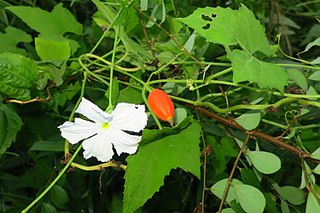
Trichosanthes cochinchinensis is a climbing plant in the family Cucurbitaceae, but the name may be unresolved, with The Plant List indicating that Gymnopetalum cochinchinense is a synonym of G. chinense(Lour.) Merr. No subspecies are listed in the Catalogue of Life, which records its distribution as: China, India, Nepal to Assam, Bhutan, Myanmar, Indonesia, Peninsular Malaysia, Borneo, Singapore, Java, Philippines, Laos, Thailand and Vietnam. In Vietnamese its name is dây cứt quạ.
Sterculia cochinchinensis is a tree species belonging to the genus Sterculia in the family Malvaceae. The name is unresolved according to The Plant List. This species is found in Laos and Vietnam and there are no subspecies listed in the Catalogue of Life.

Dasymaschalon is an Asian genus of bushy plants in the subfamily Annonoideae and tribe Uvarieae. Its native range is from southern China, Indo-China to Malesia.
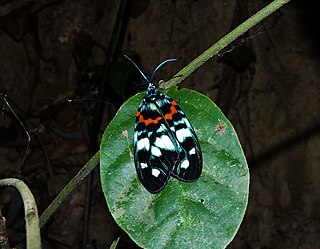
Erasmia pulchella is a species of moth in the burnet moth family Zygaenidae and in the subfamily Chalcosiinae. It was described by Frederick William Hope in 1840. It is found throughout Southeast Asia, with its range stretching from northern India, Myanmar, Laos, Thailand, Vietnam, China, Taiwan, and Japan. It is the type species of the genus Erasmia.

















